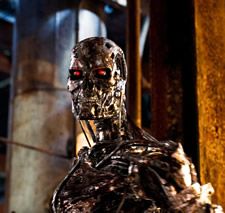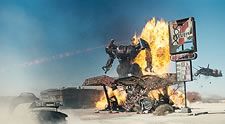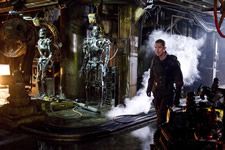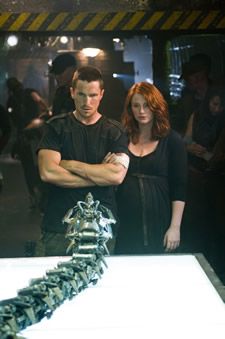
The Terminator CGI has been refined in the latest film
The Terminator is back in cinemas after a six-year hiatus that saw it get into more scrapes than its central protagonist John Connor - including a period of legal limbo thanks to a lawsuit between MGM and Warner Bros over the rights to the franchise, several changes of acting personnel and a high-profile dust-up between star Christian Bale and director of photography Shane Hurlbut.
Despite these glitches in the machine, however, it is the franchise’s special effects legacy that everyone is talking about – and living up to the groundbreaking series which brought us the first realistically human movements for a CGI character was always going to be a challenge. It’s a gauntlet visual effects veteran Charles Gibson was more than willing to pick up. The Oscar-winning technician – who also takes on the role of second unit director for Terminator Salvation – says: “It was exciting to have the opportunity to revisit the franchise armed with the tools that we have today. To be given the opportunity to come up with some new ideas that took advantage of some of the techniques that have been refined over the last couple of years.”
There are certainly plenty of effects on display, from exploding buildings and high-speed chases to flying robots and even a resurrection of Arnold Schwarzenegger as the T-800.
Charles, perhaps surprisingly, says that when it comes to robots, it’s the character that is important, so that personality is retained when the action moves between model work and CGI.

“I feel like the T-800 and Arnold Scwarzenegger are the same character skin-on and skin-off and going back to Terminator, James Cameron and Arnold created a great sort of synthesis of character. They did the best they could across the different techniques, but it was clearly different when they went from Arnold playing a robot in human skin to a Stan Winston waist-up animatronic to, finally, a stop-motion puppet.
“We had an opportunity to create something that performed consistently regardless of the ‘finish’ on it. I felt like we were always creating one character throughout the film. In one sense it’s a robot but in another it’s more than that, it’s a classic cinema character so it’s very exciting to do that and to try to keep our T-800 in character and not fall short there.”
Since the Austrian Oak has been rather busy branching out into Californian politics of late, he was recreated for a showdown in the film using a mix of live action and CGI techniques.
“There were really two phases to it,” reveals Charles “When we see sort of a facsimile of Arnold in the laboratory, that’s a body double we cast, who looks somewhat like Arnold from the neck down, with a CGI-scanned bust of Arnold from the chest up – that’s computer animation. We worked on the body to make it match Arnold precisely and, in animation, we created an Arnold head and chest. That’s in for a bit of the sequence and then, later on, when we have the chrome T-800, the endoskeleton, that’s fully animated and we had a stunt performer who was wearing a motion capture suit on set, who we directed in the scene to work with Christian Bale or Sam Worthington.
“It was just a question of keeping our reference performer in character and moving like Arnold. We spent a lot of time getting the motion right. We were really fortunate to have the continuity of the Stan Winston team with us – those people had worked on all the movies and thank goodness they were there because they were able to keep us honest and give us a lot of tips about the nature of Arnold’s performance. Little things, that seem obvious now to us like the way Arnold held his head and the way he walked and body attitude and the way he would pause before he turned – things like that which you don’t necessarily get just from watching the movie but they were there when we were developing that performance.”
But recreating Arnold from scratch wasn’t easy, although they were lucky enough to have a cast of him from the original Terminator film, meaning they could turn the clock back to 1984.

“That was brilliant,” says Charles. “It was Stan Winston’s people again. They had taken a live cast of Arnold from 1983 for the first movie because they had done make up on him and all sorts of versions of him to shoot at and hang up and all that. And there it was, pristine.
“So, we scanned it into the computer and thought: ‘Well, this is great, we’re just going to put some hair on it and it’ll look just like the Terminator.’ And, of course, it didn’t look like the Terminator, it looked like Arnold Schwarzenegger between takes relaxing, because the Terminator is a character. That was our first lesson – Arnold and James Cameron created a character and that was the beginning of the journey for us and getting our character ‘into character’ was a really fascinating process.”
It is this creating of characters that gives Charles – who has won Oscars for his work on Babe and the Pirates Of The Caribbean franchise – the biggest buzz.
“ I love to prep performance. Early in my career I did a lot of animals. I like to create through animation – or even working with animals – to create a sense of intent and action/reaction, to try to create a more sophisticated performance. I feel like the movies that mixed animated action and real characters were fairly crude. Pirates Of The Caribbean, to me, was just fantastic because I thought they were really able to capture Bill Nighy’s performance with great fidelity and that was really intriguing to me. So I would love to do more work with character.”
The end result of his character work in Terminator Salvation is impressive, although there are so many visual effects in the latest instalment that it’s hard to single one out for specific praise. Despite its full-on visuals, though, Charles says that director McG was keen to keep things rooted in reality – not least because, despite the year being 2018, this film is set before any of the others in the series. It sees the grown-up John Connor (Christian Bale) meet his own father-to-be Kyle Reese (Anton Yelchin) and face the possible threat of Terminators that incorporate human tissue (Sam Worthington), while fighting off robots that vary from underwater “eels” to gigantic Harvester Hunter Killer units.
When asked to single out his favourite visual effect, Charles, unsurprisingly, says: “It’s a little hard.

“Certainly, the CGI facsimile of Arnold is very nice. It’s short and I think that’s special. There was a conscious decision not to put in a ‘new’ thing. There wasn’t a new piece of technology because this film takes place before any of the other Terminator films in the canon. So we decided to focus our efforts on showing a much-refined version of Terminator elements we’ve seen but woven into this really amped up action context, really seamlessly.
“There are huge sequences that feature so much action and so much animation that I think are really flawlessly rendered and the effects are clean, they’re perfect and they integrate. I think we accomplished what we set out to do which is to have these Terminator elements and have a world that’s very similar to ours – this could be happening tomorrow, these things could be patrolling our streets. We based everything on existing technology, so it wasn’t too fantastic and I think we succeeded there.”
Part of the success, he says, stems from the fact that he was able to mix second unit direction with his visual effects role.
“Sometimes visual effects movies tend to sacrifice something for their setting or their vehicles or their characters,” he says “But McG at the beginning, really wisely, said that he really wanted it to feel like it took place in our world, that it was a gritty and grimy – everyone gets dirt in their mouths – and it really feels like you’re there. The ‘wow’ factor on top of that – that it’s all taking place with these Terminator science fiction elements – I think it was appropriate for me to work with both hats on. One seamlessly handed off to the other, the division of labour is not really clear in a case like that.
“I think that’s one of the strong points of the movie is that the action speaks for itself and people aren’t consciously aware of what’s animated and what’s not.”
Creating the illusion is as much about making the actors feel that things are realistic, according to Charles, meaning that it was important to give them something physical to work with.
“ Sometimes if you’re shooting an empty plate and anticipating the CGI spaceship that’s going to be in there later it can get a little calm and they don’t have that action movie rhythm that you can get. So I think the more that you can get on set, in camera, the better, certainly. It makes it a little harder to weave the visual effects into the plate but in the end it feels so much more real.”
Charles adds that despite the difference in genre between Pirates Of The Caribbean and Terminator, there are a lot of similar techniques at work in both franchises.
“Pirates took a similar approach in terms of shooting actual locations as much as possible and staying off a stage as much as possible. Shooting real boats, for example. And using onset motion capture. So there were a lot of techniques, especially with Industrial Light and Magic, which were refined on Pirates that we were able to capitalise on. I feel like this movie really benefited, at least as far as the work that ILM did, from Pirates Of The Caribbean and Iron Man.”
Charles says McG brought a velocity to the movie that really helped it to take shape, adding: “The film was in sort of a weird place when we started and he really gave it a lot of clarity. He is incredibly enthusiastic and he is the originator of all the huge ideas – the best, biggest ideas on the film.”
And, like so many who have been asked about the ‘Bale outburst’ he says he would work with the British actor again “in a second”.
“I was fortunate enough to be on second unit that day – and I wasn’t there,” he says, diplomatically. “However, when Christian worked with us on second unit I found him to be a really great guy and professional and sweet and calm. I know they were under a lot of pressure to get a lot of work done that day because they were on an airforce base and it was rather tense but I was surprised to hear about it.”
As for Terminator, Charles says if there’s a fifth, he’ll be back.
“If the timing works out that would be fantastic,” he says “I think McG’s going off to do another film at Disney right now but I’d love to see the script. I think he wants to really play with time travel - we’ve always just happened upon Arnold and the T-1000 after they’ve arrived and maybe there’s something to explore there. That could be fun.”
Terminator Salvation is in cinemas across the UK from June 3.





















